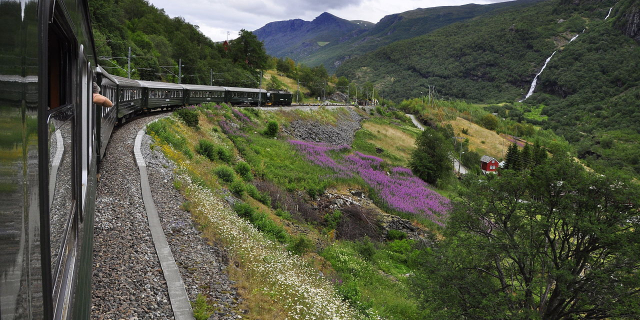Hurtigruten (lit. 'Express Route'), formally Kystruten Bergen-Kirkenes ("coastal route Bergen-Kirkenes"), is a Norwegian public coastal route transporting passengers that travel locally, regionally and between the ports of call, and also cargo between ports north of Tromsø.
Hurtigruten provides daily, year-round and consistent traffic between Bergen and Kirkenes with 34 ports of call on northbound and 33 ports of call on southbound sailings. The Ministry of Transport and Communications in Norway has set minimum capacity requirements of 320 passengers, 120 berths and cargo for 150 Euro-pallets. The current agreement with the privately held company Hurtigruten AS entered into force on 1 January 2012 and expired on 31 December 2019, with an optional 1-year extension. From 2021 the two companies Hurtigru...Read more
Hurtigruten (lit. 'Express Route'), formally Kystruten Bergen-Kirkenes ("coastal route Bergen-Kirkenes"), is a Norwegian public coastal route transporting passengers that travel locally, regionally and between the ports of call, and also cargo between ports north of Tromsø.
Hurtigruten provides daily, year-round and consistent traffic between Bergen and Kirkenes with 34 ports of call on northbound and 33 ports of call on southbound sailings. The Ministry of Transport and Communications in Norway has set minimum capacity requirements of 320 passengers, 120 berths and cargo for 150 Euro-pallets. The current agreement with the privately held company Hurtigruten AS entered into force on 1 January 2012 and expired on 31 December 2019, with an optional 1-year extension. From 2021 the two companies Hurtigruten AS and Havila Kystruten AS will operate the route.
As of April 2022, one of the ships of Havila Kystruten, MS Havila Capella, was taken out of service; because of sanctions as a result of the 2022 Invasion of Ukraine, the ship no longer had insurance; "the 4 ships of" the company were at that time financed by a Russian company.
As of March 2023, Havila Kystruten has 2 out of 4 ships in operation, Havila Capella and Havila Castor. Havila Polaris and Havila Pollux is expected to be delivered before summer 2023.
 Vesteraalen near Bodø on her first round-trip in 1893.
Vesteraalen near Bodø on her first round-trip in 1893.Hurtigruten was established in 1893 by government contract to improve communications along Norway's long, jagged coastline. Vesteraalen began the first round-trip journey from Trondheim on 2 July 1893 bound for Hammerfest, with calls at Rørvik, Brønnøy, Sandnessjøen, Bodø, Svolvær, Lødingen, Harstad, Tromsø and Skjervøy. The ship arrived at Svolvær on Monday 3 July at 8pm after 35½ hours and at Hammerfest on Wednesday 5 July after 67 hours. She was commanded by founder of the route Richard With. At that time this was the fastest route between northern and southern Norway, and this resulted in the route being named Hurtigruten (express route).[1] As of 2008, the Trondheim–Svolvær trip took 33 hours and the Trondheim–Hammerfest trip took 41 hours 15 min.[citation needed]
Before Hurtigruten opened, only Vesteraalens Dampskibsselskab was willing to make the trip through the then poorly-charted waters; the voyage was especially difficult during the long, dark winters. The company had for itself made detailed sailing instructions. Hurtigruten was a substantial breakthrough for communities along its path. Mail from central Norway to Hammerfest, which used to take three weeks in summer and five months in winter, could now be delivered in seven days.[1]
 The 1982-built Narvik in Svolvær. The ship was sold in 2007.
The 1982-built Narvik in Svolvær. The ship was sold in 2007.Encouraged by Vesteraalens' early success, several other shipping companies obtained a concession to operate the route, extended to run between Bergen in the southwest and Kirkenes in the far northeast. A fleet of 11 ships visits each of the 34 ports daily, both northbound and southbound.[citation needed]
Until the 1940s most ports north of Trondheim could not be reached by road from Oslo, so the sea was the only means of access. Beginning in the 1960s, the role of Hurtigruten changed, in part because of the construction of a local airport network and road improvements. Operating subsidies were gradually phased out, and the operators put more emphasis on tourism. New, bigger and more luxurious ships were introduced in the 1980s, with attention given to hot tubs, bars, restaurants and other comforts. However, Hurtigruten still serves important passenger and cargo needs, and operates 365 days a year. The last two independent shipping companies, Ofotens og Vesteraalens Dampskibsselskab (OVDS) and Troms Fylkes Dampskibsselskap (TFDS), merged on 1 March 2006 as the Hurtigruten Group, a year later becoming Hurtigruten ASA. In 2015 Hurtigruten was delisted from the Oslo stock exchange after the company was acquired by the private equity group TDR Capital.[2][3] In addition to the voyages in Norway, the company operates expedition cruises to Greenland, Canada, South America, Iceland, Svalbard and Antarctica.
 Havila Capella and Havila Castor meets for the first time along the coastal express route.
Havila Capella and Havila Castor meets for the first time along the coastal express route.































Add new comment